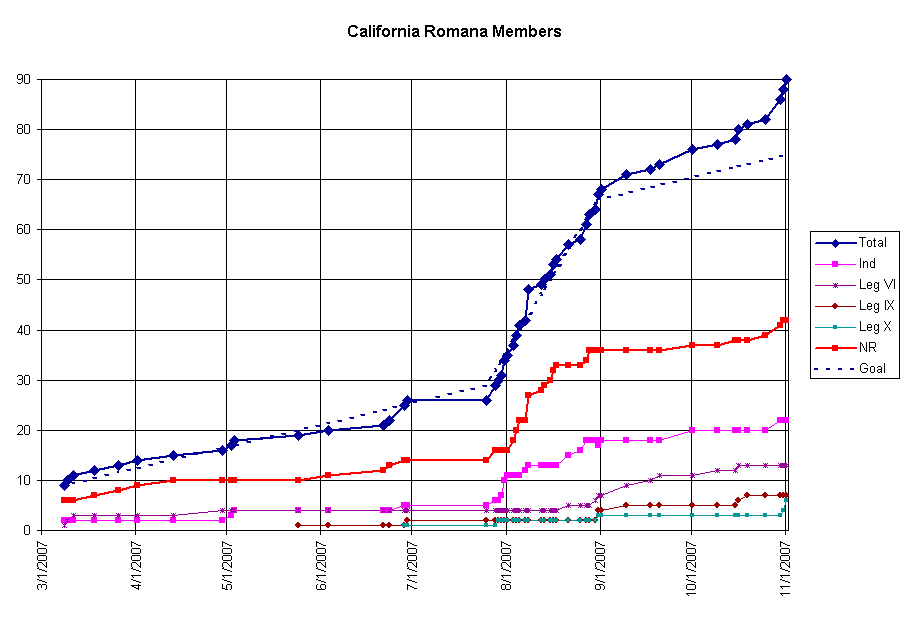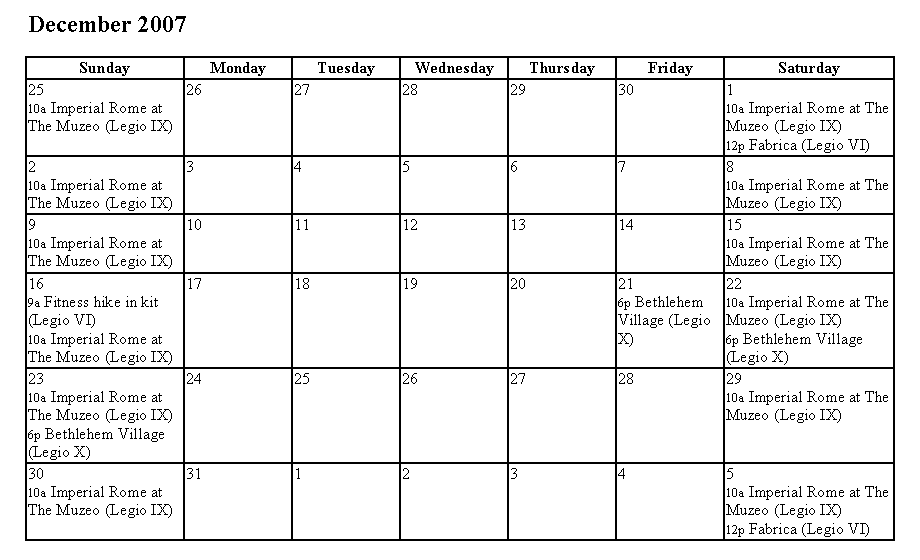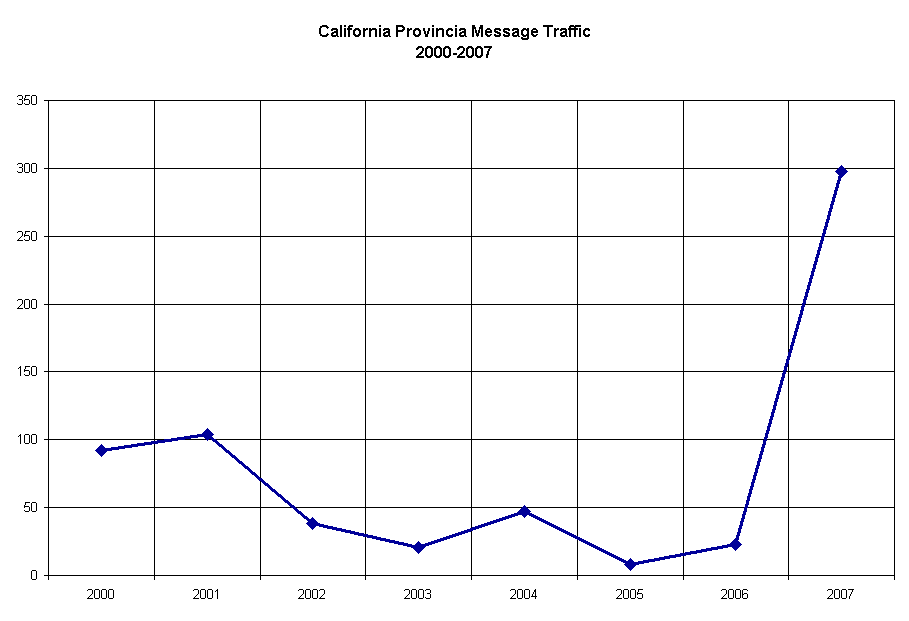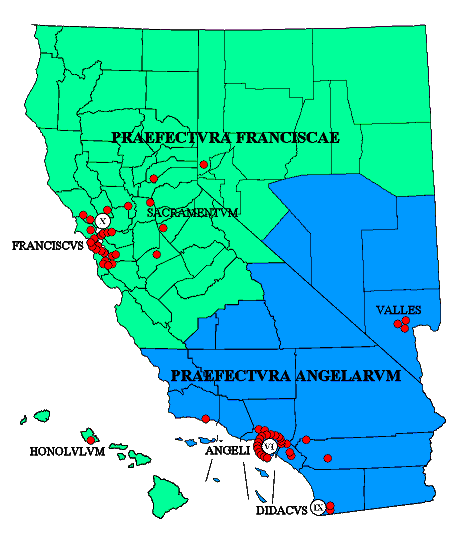California provincial report MMDCCLX
Provincia California Annual Report MMDCCLX
M. Martianius Gangalius consulibus et patribus conscriptis S. P. D.
Kal. Nov. AUC MMDCCLX
Ad S.P.Q.R., salvete,
On 25 July 2007, the consul Tiberius Galerius Paulinus appointed me as Legatus Consularis, "his personal representative within the province of California." In accordance with his Edictum Consulare XIV-MMDCCLX A.U.C. of that date, this report recounts my observations through 1 November.
On the day of my appointment I began a campaign to enlist people to the California Romana online group at an accelerated rate. I had started the group on 8 March to replace the original group created by Lucius Cornelius Sulla in 2000, because in the absence of active management, the group had fallen into ruins. Roughly three-quarters of the nearly 50 members had bouncing addresses, and the group was also beginning to be overrun by spammers. From the group’s inception on 8 March up to 25 July, the group had grown from an initial 9 members to 26, a rate of about one new member per week, which represented an approximate doubling of the valid (non-bouncing) membership from the old group at the time of its abandonment. During this period I compiled a list, from various sources, of approximately 230 potential recruits, including current and former Nova Roma citizens, members of reenactment organizations, and others; however, at no time did I have in my possession an official contact list of current Nova Roma citizens.
Sending invitations from this list at a steady rate, from 25 July to 31 August, the group membership rose from 26 to 67, a rate of one per day. It was because of my concern regarding organizational culture that I gave first priority to recruiting citizens and former citizens, so that the early organizational culture of the online group would be predominately that of Nova Roma. I deliberately managed the growth of the group at the rate of one member per day, preferring steady growth to sudden shocks to the system that might result from inviting hundreds of people in the span of a few days.
Once the list I had compiled of NR-associated people was exhausted at the end of August, I began reaching out to members of other groups, such as reenactment organizations, at a slower pace so as not to shock our group’s organizational culture. I completed this phase at the end of September. Then, cycling through this list a second time, group membership rose to 90 as of 1 November, a rate of three per week, which was triple what I expected. Furthermore, this is double the number of valid members that Sulla’s online group had at its peak, and a seven-fold increase over the number of valid members at the time of the abandonment of the previous online group in March.
In addition to inviting members of the reenactment organizations to the online group, I added the events listed on their online group calendars to the California Romana online group calendar, thus providing a central location for the schedule of activities throughout the province. I review and update this calendar on a regular basis, and it is my hope that in time others will begin using it to advertise their activities.
Since I do not have access to the list of citizens for the province, I do not know with certainty what the present status is of those I have identified through other sources as being NR-affiliated. My estimate is that approximately half of the members of the California Romana group have some affiliation, either past or present, with Nova Roma. I have exhausted my reservoir of knowledge of Nova Roma citizens and former citizens in the province; therefore, in the absence of receiving further intelligence, the incorporation of citizens and former citizens in the online group will level off. How many of these approximately 40 NR-affiliated continue or reactivate their citizenship depends on how effective the provincial government is in the coming year. As this point, it can only be said that the opportunity for a resurgence has been created. One reaction I received from a returning citizen I think typifies the situation: "I didn’t know Nova Roma was still around."
Recruitment efforts will continue among other groups dedicated to Roman culture; however, it would be preferable to continue increasing our numbers from within Nova Roma as well, lest the organizational culture of the online group begin to evolve in a direction that deviates significantly from Nova Roma. Naturally, I invite all Nova Roma citizens in our great province to join the California Romana group and to participate in building romanitas.
We have enjoyed some successes on the province’s eastern and western peripheries. The online group now includes three members in Las Vegas. Meanwhile, we are fortunate to have a new and very industrious citizen in Honolulu, Marcus Martianius Lupus, who has initiated an active and sustained recruiting effort; however, he is one person, and developing a Roman community in the islands will be a very long-term project.
There remains a residual contact list of about 130 people, but after two invitations, probably this pool is largely exhausted. Many of these are apparently former Nova Roma citizens with no intention of returning, while others are members of other online groups who are either unfamiliar with Nova Roma or do not view our organization as appealing to their interests. However, there may be hope for the 50 reenactors on this list. It has been confided to me that among the reenactment community, "Nova Roma is a joke." Although this may offend some ears in the Senate, it is nevertheless a message that ought to be heard and heeded. Fortunately, the Senate’s earlier refusal to appoint me as propraetor has turned out to have a perverse silver lining, in that introducing myself as "sort of affiliated with Nova Roma" has made reenactors less hostile and more open to dialogue. I think we can turn around Nova Roma’s unfortunate image, but it will take a long time and a lot of effort to engage the reenactment community. That one-quarter of the California Romana online group is comprised of reenactors is an encouraging beginning. Nova Roma’s "bad rep" has spread through the legions by word of mouth, based on the direct experiences of a few individuals, therefore this hostility is soft. In time, we may succeed in bringing many of them into Nova Roma as citizens.
In any case, it is clear that never before have so many California Romani of various shades been connected in one network. I believe that it creates the potential for denser sub networks to form spontaneously, and for the entrepreneurial, "bottom-up" initiation of activities, relieving much of the burden of a future provincial government to centrally plan such activities to demonstrate that "something is going on" in the province.
Commensurate with the growth in the membership of the online group has been the growth in message traffic. It is quite likely that the traffic for this year will exceed that of the previous seven years combined.
Central to the strategy of rebuilding the province is forging strong ties to the legions. Marcus Artorius Silvanus, a Nova Roma citizen, has begun efforts to form a new legion, tentatively designated Legio II Britannica. This will bring California’s military strength up to four legions and provide geographic balance, with two legions in the north as well as in the south. One of the best stimuli for interest and growth is a nearby rivalry, so the establishment of a second legion in the north may also benefit the more-established Legio X Fretensis. According to Artorius, Legio II Britannica "will cover all aspects of life in Britain during the 4th through 6th centuries CE, including both military and civilian portrayals." In contrast, as stated by its centurio, "Legio X Fretensis prefers to focus on what many call the ‘Classical Age’ of the Roman Empire: 1st Century BC and 1st Century AD." Thus, the two legions will compliment each other by concentrating on different historical periods. I would like to see an increased civilian contingent in these activities and I will probably participate in this way (I am a bit old for marching around in mail and armor in the heat of summer). A turn toward "civilian reenactment" will encourage participation across a broader demography, including all age groups as well as more women.
As new members have joined the online group, several have asked, "Are there any Romans in my area?" This points up the need to augment the online group with more face-to-face contact. In the population centers, this is not a difficult problem to solve, but it is an intractable one in outlying areas. Here is a potential value of the legions: they are mobile. Thus, they offer the possibility to Romans in remote areas that romanitas may come to a town near them for an event. A key to building romanitas in California Provincia may be the development of an integrated strategy employing mobile and static assets that provides continuity between the urban and rural areas.
Quintus Fabius Maximus points out that although the recruitment rate among college students and military personnel can be higher than for the general population, it is a mobile population. Thus, as a province, our gains evaporate over time. Fabius attributes much of the province’s population crash to graduating students and military personnel either permanently transferred out of the province or temporarily deployed overseas. What should be ascertained, however, is whether such people maintain their citizenship following relocation. If so, there is a permanent value to Nova Roma, and the provincial government should be recognized for its contribution to the whole rather than criticized for its own losses. If a soldier loses his arm in the defense of ten men, ought he to be damned for having rendered himself unable to engage in future combat?
With the rise in the number of people connected to and in communication with each other, we can look to more activities. The tie between head count and activities is illustrated by the reflection of Fabius:
- "Cornelia and I organized the Gladiator stable at [the University of Southern California] which was very popular. We also organized a classical reading project in [the University of San Diego]. We had dinners, and workshops. However people have to attend to get the benefit. As the population sank, events floundered because of lack of participation. At the annual ‘Dinner with the Proconsul’ last year we had four CAL members attend and two were from my Gens. This was down greatly from the 2002 dinner with 25. In closing I suspect as we have some events organized, that will be failures at first. Only after new citizens believe these are legitimate annual events, will attendance climb."
Artorius has responded enthusiastically to my suggestion of establishing an annual event in the San Francisco Bay Area of similar scope to legion participation in Old Fort MacArthur Days in the Los Angeles area, and he has agreed to undertake this project. Also, the reopening of the Getty Villa in Malibu, a faithful re-creation of a Campanian villa that houses one of the world’s greatest collections of Roman antiquities, may present opportunities for future events. Leona and I toured the villa in May, and it is something that every Roman should experience.
Hand in hand with the rebuilt communications network and the revival of activities must be a vision for organization. It has been impossible to build a credible organization because the Senate has provided no clear line of authority. In addition to attracting a staff to which to delegate tasks, my advice to the next governor would be to create two organizational structures, one based on geography, and one knitting together the various Roman organizations in California.
First, the next governor should establish praefecturae, each with its appointed praefectus, based on the population centers. The criteria for establishment of a praefectura might be something along the lines of ten online group members, five of whom are Nova Roma citizens. At present, only two urbis would qualify, although the plan should be laid for more praefecturae as the opportunities present themselves. In addition to these praefecti, I would suggest appointing a praefectus praetorio, a title of honor, from among the legion commanders who are Nova Roma citizens, perhaps initially rotated among the legions so that all are included one time, then appointed on the basis of competition at a reenactment event. This would build stronger ties to the legions and encourage citizenship.
Second, the fact that the Nova Roma organization has been historically loose and extended over a large geographic area, whereas the legions have strong, well-established local networks, suggests that we should draw from our disparate strengths and compensate for each others’ weaknesses. A Consilium Californicus might be formed to bring together all of the elements of romanitas as equals to coordinate development strategies to our mutual benefit. I envision a Consilium composed of two members from each organization, plus one independent member elected via an online poll of the California Romana group to serve as a tiebreaker.
Citizenship in Nova Roma would not be a qualification for a seat on the Consilium, although one can hope that over time this would shift from being the exception to being the norm. To those in the Senate who might be disposed to view with alarm the establishment of a deliberative body largely outside of Nova Roma, I would say that here in California, Nova Roma can ill-afford to be viewed as barging in and trying to run things its own way. We can suggest, but we cannot dictate; we should strive for an alliance, not an empire.
In conclusion, my thanks to Galerius and Fabius for their counsel and assistance, and it is my opinion that Quintus Fabius Maximus should be restored as governor of California.
Optime valete,
M. Martianius Gangalius
Legatus Consularis
Master Index > English > Nova Roma > Nova Roma History
Master Index > English > Nova Roma > Res publica (Nova Roma) > Magistracies (Nova Roma) > Magistrates (Nova Roma)
Master Index > English > Nova Roma > Res publica (Nova Roma) > Provinciae (Nova Roma) > Provincia California (Nova Roma)
Master Index > Maintenance Categories > Pages to be deleted > MMDCCLX
Provinciae (Nova Roma)



